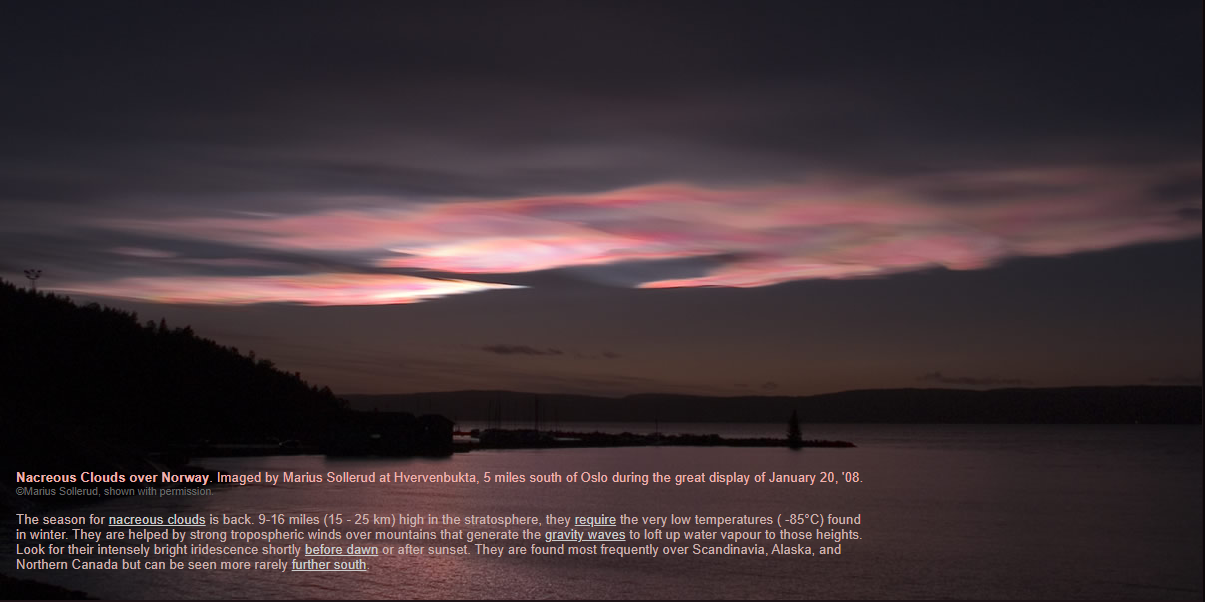Now is the season ..
Now is the Season for Nacreous Clouds: A Spectacular Atmospheric Phenomenon
Nacreous clouds, also known as mother-of-pearl clouds, are a breathtaking atmospheric phenomenon that occurs during the winter season. These ethereal clouds form in the stratosphere, approximately 9-16 miles (15-25 km) above the Earth's surface. They require extremely low temperatures, reaching as low as -85°C, which are typically found during winter months. The combination of these frigid temperatures and strong tropospheric winds over mountains creates gravity waves that lift water vapor to the heights where nacreous clouds can form.
The Enchanting Iridescence of Nacreous Clouds
One of the most remarkable features of nacreous clouds is their intensely bright iridescence. This captivating display of colors can be observed shortly before dawn or after sunset, adding a touch of magic to the sky. The iridescence is caused by the diffraction and scattering of sunlight by tiny ice crystals within the clouds. These ice crystals are oriented in such a way that they refract sunlight and create stunning hues of pinks, purples, blues, and greens.
Where to Spot Nacreous Clouds
Nacreous clouds are most commonly found over regions such as Scandinavia, Alaska, and Northern Canada. However, they can occasionally be seen further south, although more rarely. Their occurrence is closely linked to the specific atmospheric conditions required for their formation. The combination of low temperatures and strong tropospheric winds over mountainous areas provides the ideal environment for nacreous clouds to manifest.
Understanding the Formation Process
To fully appreciate the beauty of nacreous clouds, it is essential to understand their formation process. The extreme cold temperatures in the stratosphere cause water vapor to freeze into ice crystals. These ice crystals then attach themselves to meteoric dust particles, creating the necessary nuclei for cloud formation. As the gravity waves generated by the tropospheric winds over mountains lift the water vapor to higher altitudes, the ice crystals grow larger and become more visible, eventually forming the characteristic nacreous clouds.
The Importance of Stratospheric Conditions
Nacreous clouds serve as indicators of specific stratospheric conditions. Their presence suggests the existence of polar stratospheric clouds (PSCs), which play a crucial role in the depletion of ozone. PSCs provide a surface on which chemical reactions occur, leading to the release of chlorine and bromine compounds. These compounds are responsible for the destruction of ozone molecules, contributing to the formation of the infamous ozone hole.
Scientific Research and Observation
Nacreous clouds have fascinated scientists and sky watchers for centuries. Researchers have conducted extensive studies to better understand the physics behind their formation and their implications for atmospheric dynamics. Satellites and ground-based instruments are utilized to gather data on nacreous clouds, aiding in the analysis of their composition, altitude, and spatial distribution. By studying these unique cloud formations, scientists can gain valuable insights into the complex interactions occurring within Earth's atmosphere.
Appreciating Nature's Spectacle
Witnessing the beauty of nacreous clouds is a truly awe-inspiring experience. These rare and stunning atmospheric displays remind us of the incredible diversity and complexity of our planet. Taking the time to observe and appreciate these natural wonders can foster a deeper connection with the world around us and inspire a sense of wonder and curiosity about the mysteries of the atmosphere.
In conclusion, now is the season to keep an eye on the sky for nacreous clouds. These extraordinary phenomena occur during winter months when extremely low temperatures and strong tropospheric winds combine to create the ideal conditions for their formation. The intense iridescence, unique distribution patterns, and scientific significance make nacreous clouds a captivating subject of study and observation. So, next time you find yourself outside before dawn or after sunset, take a moment to look up and marvel at the enchanting display of colors painted across the sky by these extraordinary clouds.

Nacreous Clouds over Norway. Imaged by Marius Sollerud at Hvervenbukta, 5 miles south of Oslo during the great display of January 20, '08. ©Marius Sollerud, shown with permission.
The season for nacreous clouds is back. 9-16 miles (15 - 25 km) high in the stratosphere, they require the very low temperatures ( -85°C) found in winter. They are helped by strong tropospheric winds over mountains that generate the gravity waves to loft up water vapour to those heights. Look for their intensely bright iridescence shortly before dawn or after sunset. They are found most frequently over Scandinavia, Alaska, and Northern Canada but can be seen more rarely further south.
Note: this article has been automatically converted from the old site and may not appear as intended. You can find the original article here.
Reference Atmospheric Optics
If you use any of the definitions, information, or data presented on Atmospheric Optics, please copy the link or reference below to properly credit us as the reference source. Thank you!
-
<a href="https://atoptics.co.uk/blog/now-is-the-season/">Now is the season ..</a>
-
"Now is the season ..". Atmospheric Optics. Accessed on November 26, 2024. https://atoptics.co.uk/blog/now-is-the-season/.
-
"Now is the season ..". Atmospheric Optics, https://atoptics.co.uk/blog/now-is-the-season/. Accessed 26 November, 2024
-
Now is the season ... Atmospheric Optics. Retrieved from https://atoptics.co.uk/blog/now-is-the-season/.